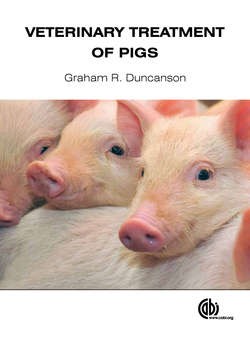Читать книгу Veterinary Treatment of Pigs - Graham R Duncanson - Страница 111
На сайте Литреса книга снята с продажи.
Saliva
ОглавлениеSaliva is an interesting tool because of its potential to reflect both oral and systemic health conditions and, with the advent of proteomics, biomarkers can be identified for specific pathological disease processes to help in the early detection of disease in farm animals. A study in Spain (Guiterrez et al., 2012) discovered potential salivary markers for systemic disease in pigs. Saliva samples can be obtained by allowing the pig to chew on a sponge for 2 min. Serological results can show positive results for PRRS, swine influenza virus (SIV) and porcine circovirus type 2 (PCV-2).
Fig. 3.1. The pigs need to be kept out of their house to examine them.
Table 3.1. Reference levels for the clinical examination of pigs.
| Parameter | Values |
| Body temperature | Lower critical point, 38.4°C; normal, 39°C; upper critical point, 40°C |
| Pulse | 70–80 beats/min, rising to 250 beats/min in the newborn piglet |
| Respiration rate | Adults, 10–20 breaths/min; growers, 20–30 breaths/min; newborns, 40–50 breaths/min |
Table 3.2. Normal haematological parameters in pigs.
| Parameter | Normal range |
| Packed cell volume (PCV) | 37–46% |
| Red blood cells (RBCs) | 6.5–8.0 ×1012/l |
| White blood cells (WBCs) | 10.0–23.0 × 109/l |
| Platelets | 250–700 × 109/l |
| Haemoglobin (Hb) | 11.0–14.2 g/dl |
